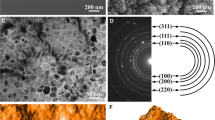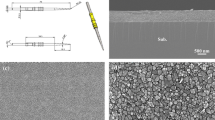Abstract
Background
Thermal injury and tissue sticking, which influence wound remodeling, are major concerns in electrosurgery. In this study, the effect of lateral thermal injury caused by different electrosurgical electrodes on hepatic remodeling was investigated.
Methods
A monopolar electrosurgical unit equipped with untreated stainless steel (SS) and chromium nitride coated stainless steel (CrN-SS) electrodes was used to create lesions on the liver lobes of adult rats. Animals were sacrificed for evaluations at 0, 3, 7, and 28 days postoperatively.
Results
CrN-SS needles generated lower levels of sticking tissue, and the thermographs showed that recorded highest temperature in liver tissue from the CrN-SS needle group was significantly lower than in the SS needle group. The total injury area of livers treated with CrN-SS needles was significantly lower than livers treated with SS needles at each time point. Moreover, the CrN-SS needles caused a relatively smaller area of lateral thermal injury, a smaller area of fibrotic tissue, and a faster process of hepatic remodeling in rat liver than the SS needles. Immunofluorescence staining and Western blot analysis showed that rats treated with CrN-SS needles expressed lower levels of NF-κB and caspase-3 postoperatively.
Conclusions
This study reveals that the plating of electrodes with a CrN film is an efficient method for improving the performance of electrosurgical units and should benefit wound remodeling. However, more tests must be performed to confirm these promising findings in human patients.









Similar content being viewed by others
References
Massarweh NN, Cosgriff N, Slakey DP (2006) Electrosurgery: history, principles, and current and future uses. J Am Coll Surg 202:520–530
Song C, Tang B, Campbell PA, Cuschieri A (2009) Thermal spread and heat absorbance differences between open and laparoscopic surgeries during energized dissections by electrosurgical instruments. Surg Endosc 23:2480–2487
Shamim M (2009) Diathermy vs. scalpel skin incisions in general surgery: double-blind, randomized, clinical trial. World J Surg 33:1594–1599
Brown DB (2005) Concepts, considerations, and concerns on the cutting edge of radiofrequency ablation. J Vasc Interv Radiol 16:597–613
Brill AI (2008) Bipolar electrosurgery: convention and innovation. Clin Obstet Gynecol 51:153–158
Al Sahaf OS, Vega-Carrascal I, Cunningham FO, McGrath JP, Bloomfield FJ (2007) Chemical composition of smoke produced by high-frequency electrosurgery. Ir J Med Sci 176:229–232
Ulmer BC (2008) The hazards of surgical smoke. AORN J 87:721–734 quiz 735-728
Morales JP, Sabharwal T, Georganas M, Dourado R, Cahill D, Adam A (2008) Cold saline irrigation of the renal pelvis during radiofrequency ablation of a central renal neoplasm: a case report. J Med Case Rep 2:40
Dodde RE, Gee JS, Geiger JD, Shih AJ (2010) Monopolar electrosurgical thermal management system to reduce lateral thermal damage during surgery. J Med Devices 4:027505
Galloro G, Magno L, Ruggiero S, Iovino P, Formisano C, Cortese L, Fusco F, Meola C, Carlomagno GM (2013) Comparison between tungsten and steel polypectomy snares: evaluation of depth of colonic thermal wall injury in a pig model. Endoscopy 45:121–126
Ceviker N, Keskil S, Baykaner K (1998) A new coated bipolar coagulator: technical note. Acta Neurochir 140:619–620
Waritz RS (1975) An industrial approach to evaluation of pyrolysis and combustion hazards. Environ Health Perspect 11:197–202
Oberdorster G, Gelein RM, Ferin J, Weiss B (1995) Association of particulate air pollution and acute mortality: involvement of ultrafine particles? Inhal Toxicol 7:111–124
Conde A, Cristobal AB, Fuentes G, Tate T, de Damborenea J (2006) Surface analysis of electrochemically stripped CrN coatings. Surf Coat Technol 201:3588–3595
Jagielski J, Khanna AS, Kucinski J, Mishra DS, Racolta P, Sioshansi P, Tobin E, Thereska J, Uglov V, Vilaithong T, Viviente J, Yang SZ, Zalar A (2000) Effect of chromium nitride coating on the corrosion and wear resistance of stainless steel. Appl Surf Sci 156:47–64
Nevelos J (2004) Surface engineering of prosthetic knee components. Knee 11:163–167
Galvin AL, Williams S, Hatto P, Thompson J, Isaac G, Stone M, Ingham E, Fisher J (2005) Comparison of wear of ultra high molecular weight polyethylene acetabular cups against alumina ceramic and chromium nitride coated femoral heads. Wear 259:972–976
Chowdhury KK, Meftahuzzaman SM, Rickta D, Chowdhury TK, Chowdhury BB, Ireen ST (2011) Electrosurgical smoke: a real concern. Mymensingh Med J 20:507–512
Lewin JM, Brauer JA, Ostad A (2011) Surgical smoke and the dermatologist. J Am Acad Dermatol 65:636–641
Wu B, Fu Y, Xu J, Lin GQ, Hou M (2009) Chromium nitride films on stainless steel as bipolar plate for proton exchange membrane fuel cell. J Power Sour 194:976–980
McGahan JP, Brock JM, Tesluk H, Gu WZ, Schneider P, Browning PD (1992) Hepatic ablation with use of radio-frequency electrocautery in the animal model. J Vasc Interv Radiol 3:291–297
Mayrhofer PH, Rovere F, Moser M, Strondl C, Tietema R (2007) Thermally induced transitions of CrN thin films. Scripta Materialia 57:249–252
Barshilia HC, Selvakumar N, Deepthi B, Rajam KS (2006) A comparative study of reactive direct current magnetron sputtered CrAlN and CrN coatings. Surf Coat Technol 201:2193–2201
Mikami T, Minamida Y, Koyanagi I, Houkin K (2007) Novel bipolar forceps with protein repellence using gold-polytetrafluoroethylene composite film. Neurosurgery 60:157–160
Mikami T, Takahashi A, Hashi K, Gasa S, Houkin K (2004) Performance of bipolar forceps during coagulation and its dependence on the tip material: a quantitative experimental assay. J Neurosurg 100:133–138
Chiu SM, Hwang SJ, Chu CW, Gan DS (2006) The influence of Cr-based coating on the adhesion force between epoxy molding compounds and IC encapsulation mold. Thin Solid Films 515:285–292
Kuze E, Teramoto T, Yukimura K, Maruyama T (2002) Contact angle of water on chromium nitride thin film prepared on three-dimensional materials by chromium plasma-based ion implantation. Surf Coat Technol 158:577–581
Maude J, Hassan H, Audrey A, Gilles R, Guillaume DTM (2012) Antifouling stainless steel surface: competition between roughness and surface energy. Material Sci Forum 706–709:2523–2528
Knittel T, Mehde M, Grundmann A, Saile B, Scharf JG, Ramadori G (2000) Expression of matrix metalloproteinases and their inhibitors during hepatic tissue repair in the rat. Histochem Cell Biol 113:443–453
Elmore S (2007) Apoptosis: a review of programmed cell death. Toxicol Pathol 35:495–516
Pai VP, Horseman ND (2011) Multiple cellular responses to serotonin contribute to epithelial homeostasis. PLoS ONE 6:e17028
Vallabhapurapu S, Karin M (2009) Regulation and function of NF-kappaB transcription factors in the immune system. Annu Rev Immunol 27:693–733
Skaug B, Jiang X, Chen ZJ (2009) The role of ubiquitin in NF-kappaB regulatory pathways. Annu Rev Biochem 78:769–796
Schmid JA, Birbach A (2008) IkappaB kinase beta (IKKbeta/IKK2/IKBKB)—a key molecule in signaling to the transcription factor NF-kappaB. Cytokine Growth Factor Rev 19:157–165
Luedde T, Schwabe RF (2011) NF-kappaB in the liver–linking injury, fibrosis and hepatocellular carcinoma. Nat Rev Gastroenterol Hepatol 8:108–118
Zheng ZY, Weng SY, Yu Y (2009) Signal molecule-mediated hepatic cell communication during liver regeneration. World J Gastroenterol 15:5776–5783
Friedman SL (2000) Molecular regulation of hepatic fibrosis, an integrated cellular response to tissue injury. J Biol Chem 275:2247–2250
Svegliati-Baroni G, De Minicis S, Marzioni M (2008) Hepatic fibrogenesis in response to chronic liver injury: novel insights on the role of cell-to-cell interaction and transition. Liver Int 28:1052–1064
Moriya K, Bae E, Honda K, Sakai K, Sakaguchi T, Tsujimoto I, Kamisoyama H, Keene DR, Sasaki T, Sakai T (2011) A fibronectin-independent mechanism of collagen fibrillogenesis in adult liver remodeling. Gastroenterology 140:1653–1663
Alwayn IP, Verbesey JE, Kim S, Roy R, Arsenault DA, Greene AK, Novak K, Laforme A, Lee S, Moses MA, Puder M (2008) A critical role for matrix metalloproteinases in liver regeneration. J Surg Res 145:192–198
Acknowledgments
The authors thank the Center of Excellence for Clinical Trial and Research in Neurology and Neurosurgery, Taipei Medical University-Wan Fang Hospital for financially supporting this research under contract No. DOH102-TD-B-111-003, supported partly by the Department of Health, Executive Yuan, Taiwan under contract No. DOH102-TD-N-111-001.
Disclosures
Keng-Liang Ou, Jan-Show Chu, Hossein Hosseinkhani, Jeng-Fong Chiou, and Chih-Hua Yu have no conflicts of interest or financial ties to disclose.
Author information
Authors and Affiliations
Corresponding author
Rights and permissions
About this article
Cite this article
Ou, KL., Chu, JS., Hosseinkhani, H. et al. Biomedical nanostructured coating for minimally invasive surgery devices applications: characterization, cell cytotoxicity evaluation and an animal study in rat. Surg Endosc 28, 2174–2188 (2014). https://doi.org/10.1007/s00464-014-3450-9
Received:
Accepted:
Published:
Issue Date:
DOI: https://doi.org/10.1007/s00464-014-3450-9




